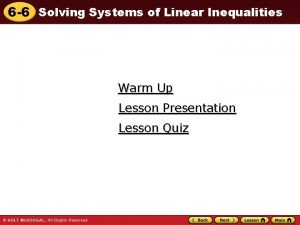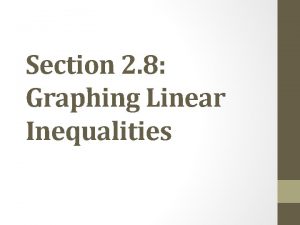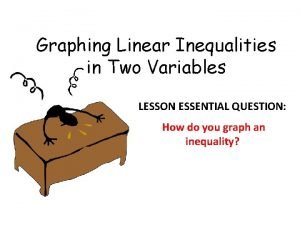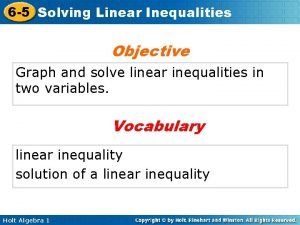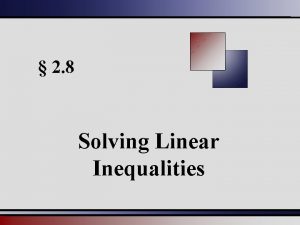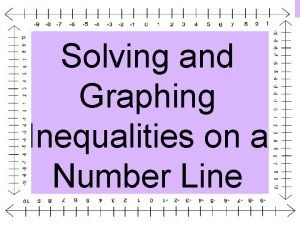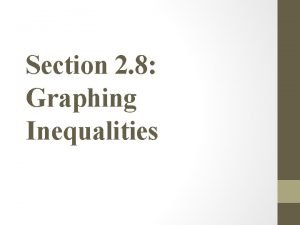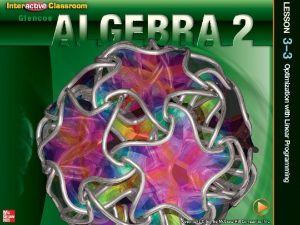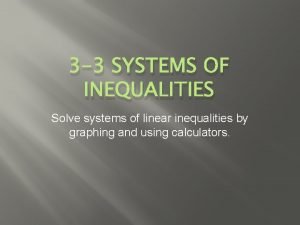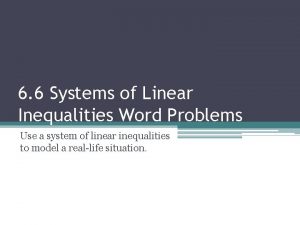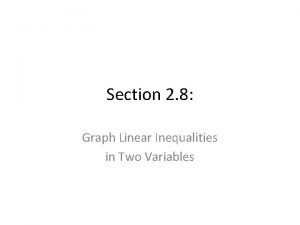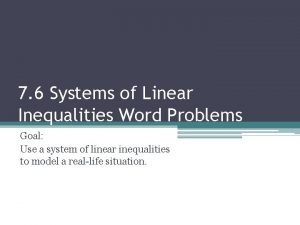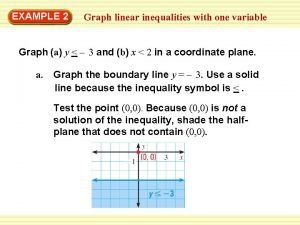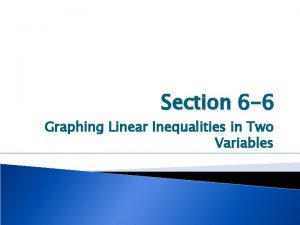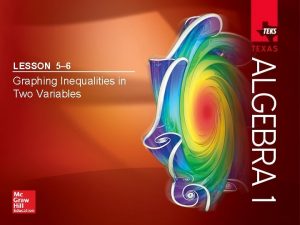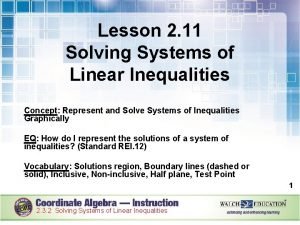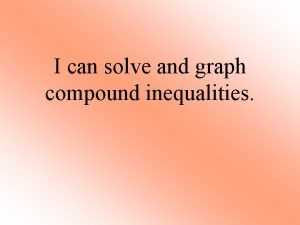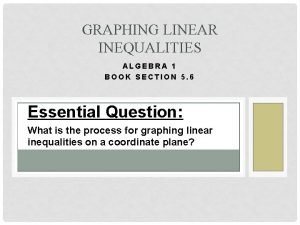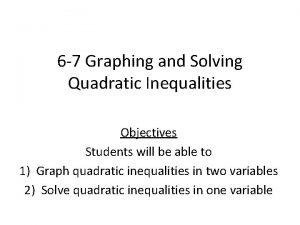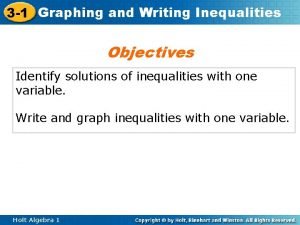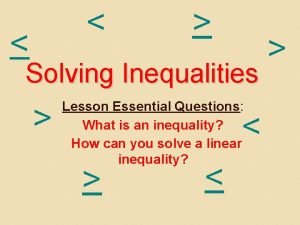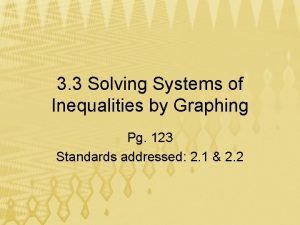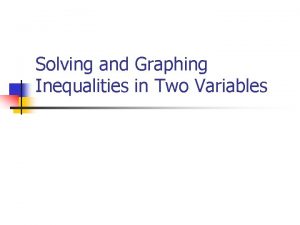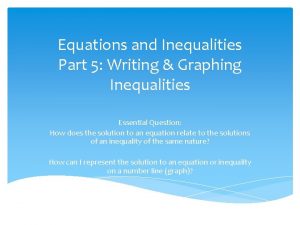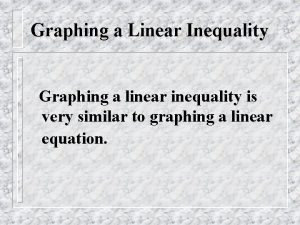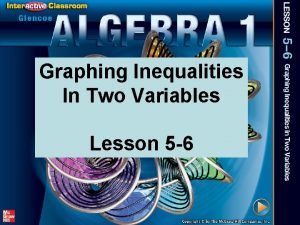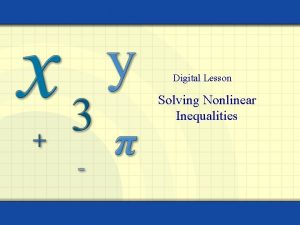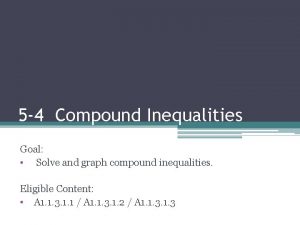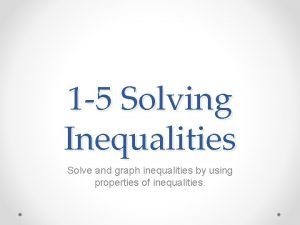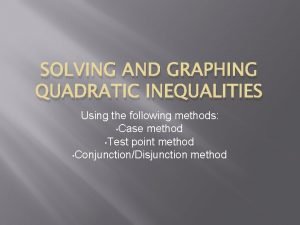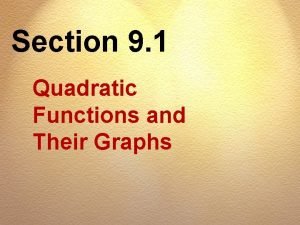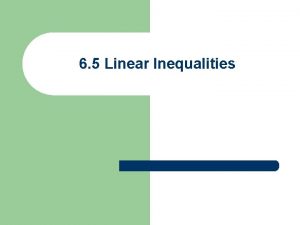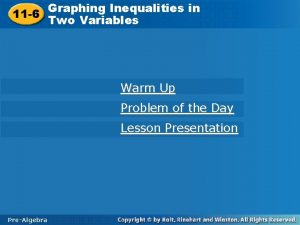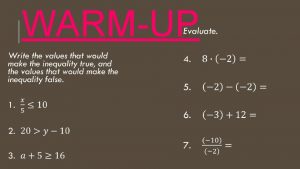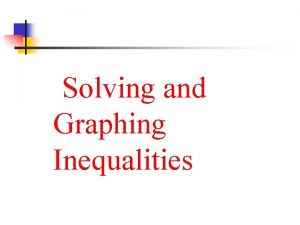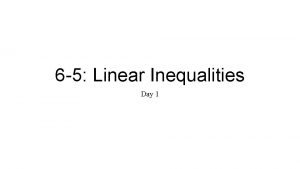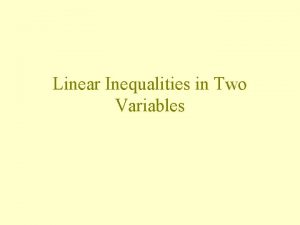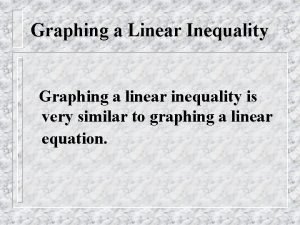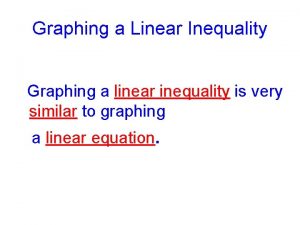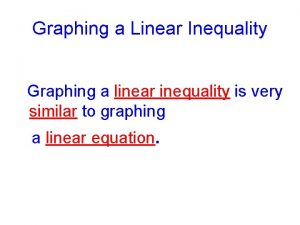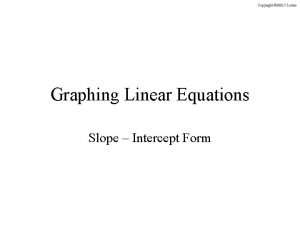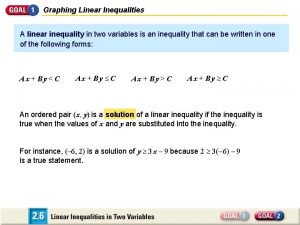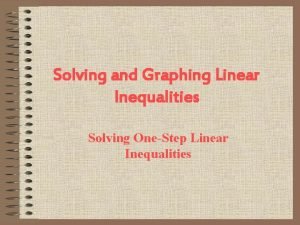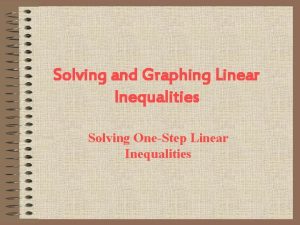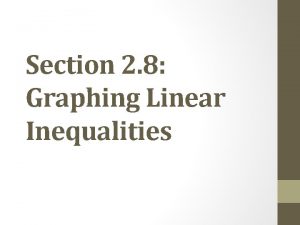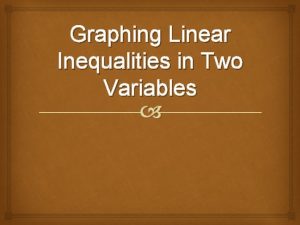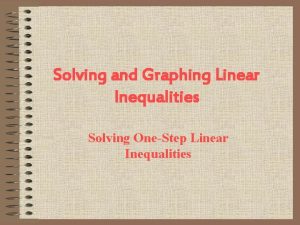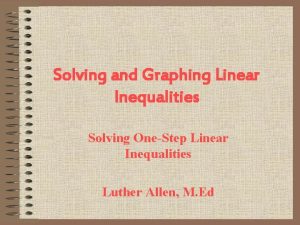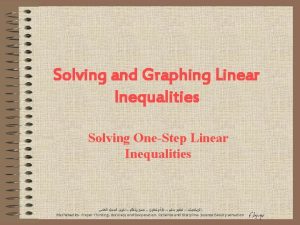3 7 Graphing Linear Inequalities Graphing Inequalities in



































- Slides: 35

3. 7 - Graphing Linear Inequalities Graphing Inequalities in Two Variables Are the ordered pairs a solution to the problem?

3. 7 - Graphing Linear Inequalities Graphing Inequalities in Two Variables Are the ordered pairs a solution to the problem?

3. 7 - Graphing Linear Inequalities Graphing Inequalities in Two Variables Are the ordered pairs a solution to the problem? .

3. 7 - Graphing Linear. Inequalities Graphing Inequalities in Two Variables Graph the solution.

3. 7 - Graphing Linear Inequalities Graphing Inequalities in Two Variables Graph the solution.

3. 7 - Graphing Linear Inequalities Graphing Inequalities in Two Variables Graph the solution.

3. 7 - Graphing Linear Inequalities Graphing Inequalities in Two Variables Graph the solution.

4. 1 - Systems of Linear Equations (2 variables) Solving Systems of Linear Equations by Graphing A system of linear equations allows the relationship between two or more linear equations to be compared analyzed.

4. 1 - Systems of Linear Equations (2 variables) Solving Systems of Linear Equations by Graphing Determine whether (3, 9) is a solution of the following system. Both statements are true, therefore (3, 9) is a solution to the given system of linear equations.

4. 1 - Systems of Linear Equations (2 variables) Solving Systems of Linear Equations by Graphing Determine whether (3, -2) is a solution of the following system. Both statements are not true, therefore (3, -2) is not a solution to the given system of linear equations.

4. 1 - Systems of Linear Equations (2 variables) Solving Systems of Linear Equations by Graphing

4. 1 - Systems of Linear Equations (2 variables) Solving Systems of Linear Equations by Graphing

4. 1 - Systems of Linear Equations (2 variables) Solving Systems of Linear Equations by Graphing

4. 1 - Systems of Linear Equations (2 variables) Solving Systems of Linear Equations by Graphing Special Systems of Linear Equations Consistent system has at least one solution. Inconsistent system has no solution. Independent equations have different graphs. Dependent equations have identical graphs. Consistent system Independent equations

4. 1 - Systems of Linear Equations (2 variables) Solving Systems of Linear Equations by Graphing Special Systems of Linear Equations Consistent system has at least one solution. Inconsistent system has no solution. Independent equations have different graphs. Dependent equations have identical graphs. Inconsistent system Independent equations

4. 1 - Systems of Linear Equations (2 variables) Solving Systems of Linear Equations by Graphing Special Systems of Linear Equations Consistent system has at least one solution. Inconsistent system has no solution. Independent equations have different graphs. Dependent equations have identical graphs. Consistent system Dependent equations

4. 1 - Systems of Linear Equations (2 variables) Solving Systems of Linear Equations by Substitution Solution

4. 1 - Systems of Linear Equations (2 variables) Solving Systems of Linear Equations by Substitution Solution

4. 1 - Systems of Linear Equations (2 variables) Solving Systems of Linear Equations by Elimination

4. 1 - Systems of Linear Equations (2 variables) Solving Systems of Linear Equations by Elimination Solution

4. 1 - Systems of Linear Equations (2 variables) Solving Systems of Linear Equations by Elimination Solution

4. 1 - Systems of Linear Equations (2 variables) Solving Systems of Linear Equations by Elimination Solution

4. 1 - Systems of Linear Equations (2 variables) Solving Systems of Linear Equations by Elimination Solution (lines are the same)

4. 1 - Systems of Linear Equations (2 variables) Solving Systems of Linear Equations by Elimination No Solution (lines are parallel)

4. 3 - Systems of Linear Equations and Problem Solving The consumption of red meat and poultry are defined by the given equations, where x represents the number of years since 2003 and y represents the pounds per year consumed. In what year will the consumption be the same? Substitution Method

4. 3 - Systems of Linear Equations and Problem Solving The consumption of red meat and poultry are defined by the given equations, where x represents the number of years since 2003 and y represents the pounds per year consumed. In what year will the consumption be the same? Substitution Method

4. 3 - Systems of Linear Equations and Problem Solving A first number is seven greater than a second number. Twice the first number is four more than three times the second number. What are the numbers? 1 st number is x, 2 nd number is y Substitution Method Solution

4. 3 - Systems of Linear Equations and Problem Solving Two trains leave Tulsa, one traveling north and the other south. After four hours, they are 376 miles apart. If one train is traveling ten miles per hour faster than the other, what is the speed of each train? Train Rate Time Distance North x y 4 4 4 x 4 y South Substitution Method

4. 3 - Systems of Linear Equations and Problem Solving One solution contains 20% acid and a second solution contains 50% acid. How many ounces of each solution should be mixed in order to have sixty ounces of a 30% solution? Solution Ounces Decimal Pure Acid 20% x y 60 0. 2 0. 5 0. 3 0. 2 x 0. 5 y (60)(0. 3) 50% 30%

4. 3 - Systems of Linear Equations and Problem Solving One solution contains 20% acid and a second solutions contains 50% acid. How many ounces of each solution should be mixed in order to have sixty ounces of a 30% solution? Elimination Method

4. 5 – Systems of Linear Inequalities Graphing Inequalities in Two Variables Graph the Union.

4. 5 – Systems of Linear Inequalities Graphing Inequalities in Two Variables Graph the solution (Graph the intersection).

4. 5 – Systems of Linear Inequalities Graphing Inequalities in Two Variables Graph the union.

4. 5 – Systems of Linear Inequalities Graphing Inequalities in Two Variables Graph the solution. (Graph the intersection)

4. 5 – Systems of Linear Inequalities Graphing Inequalities in Two Variables Graph the solution. (Graph the intersection)
 Solving systems of linear inequalities quiz
Solving systems of linear inequalities quiz Graphing linear inequalities
Graphing linear inequalities 2-8 graphing linear inequalities
2-8 graphing linear inequalities Steps in graphing linear inequalities in two variables
Steps in graphing linear inequalities in two variables Graphing linear inequalities notes
Graphing linear inequalities notes Graphing linear inequalities
Graphing linear inequalities Graphing linear inequalities on a number line
Graphing linear inequalities on a number line 2-8 graphing linear inequalities
2-8 graphing linear inequalities Bounded or unbounded graph
Bounded or unbounded graph Trigonometric functions maze
Trigonometric functions maze Solve systems of linear inequalities by graphing calculator
Solve systems of linear inequalities by graphing calculator Systems of inequalities word problems
Systems of inequalities word problems 2-8 graphing linear inequalities
2-8 graphing linear inequalities Mary babysits for $4 per hour
Mary babysits for $4 per hour Linear inequality in one variable example
Linear inequality in one variable example Graphing two-variable linear inequalities assignment
Graphing two-variable linear inequalities assignment 5-6 graphing inequalities in two variables
5-6 graphing inequalities in two variables Graphing systems of inequalities lesson 2-2
Graphing systems of inequalities lesson 2-2 Graphing compound inequalities
Graphing compound inequalities Graphing inequalities algebra 1
Graphing inequalities algebra 1 Graphing inequalities on ti 84
Graphing inequalities on ti 84 How to solve quadratic inequalities algebraically
How to solve quadratic inequalities algebraically Graphing and writing inequalities
Graphing and writing inequalities How to calculate ratio
How to calculate ratio 3-3 solving systems of inequalities by graphing
3-3 solving systems of inequalities by graphing Nnnx2
Nnnx2 Writing and graphing inequalities
Writing and graphing inequalities Quadratic inequalities shading
Quadratic inequalities shading Inequality shading rules
Inequality shading rules 5-6 graphing inequalities in two variables answer key
5-6 graphing inequalities in two variables answer key 2-6 nonlinear inequalities
2-6 nonlinear inequalities 5-4 practice solving compound inequalities
5-4 practice solving compound inequalities 1-5 solving equations and inequalities by graphing
1-5 solving equations and inequalities by graphing Graphing quadratic inequalities
Graphing quadratic inequalities 2-1 graphing and writing inequalities
2-1 graphing and writing inequalities Solve the system of inequalities by graphing y -x+3 y x-1
Solve the system of inequalities by graphing y -x+3 y x-1
